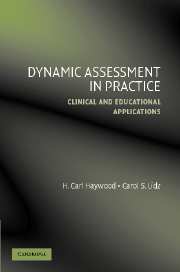Book contents
- Frontmatter
- Contents
- Preface
- Foreword, by Kenneth A. Dodge
- Foreword, by Thomas Oakland
- PART ONE THEORY AND PRINCIPLES
- PART TWO APPLICATIONS
- 4 Dynamic Assessment in Clinical Settings
- 5 Dynamic Assessment in Educational Settings
- 6 Applying Dynamic Assessment with Young Children
- 7 Applying Dynamic Assessment with School-Age Children
- 8 Applying Dynamic Assessment with Adults and Seniors
- 9 Writing Reports and Developing IEPs and Service Plans with Dynamic Assessment
- 10 Unresolved Issues, Conclusions, and Recommendations
- APPENDIX A TESTS REFERRED TO IN THE TEXT THAT DO NOT BELONG TO THE AUTHORS
- APPENDIX B SOURCES OF DYNAMIC ASSESSMENT MATERIALS
- References
- Author Index
- Subject Index
- Tests and Testing Materials Index
10 - Unresolved Issues, Conclusions, and Recommendations
Published online by Cambridge University Press: 04 December 2009
- Frontmatter
- Contents
- Preface
- Foreword, by Kenneth A. Dodge
- Foreword, by Thomas Oakland
- PART ONE THEORY AND PRINCIPLES
- PART TWO APPLICATIONS
- 4 Dynamic Assessment in Clinical Settings
- 5 Dynamic Assessment in Educational Settings
- 6 Applying Dynamic Assessment with Young Children
- 7 Applying Dynamic Assessment with School-Age Children
- 8 Applying Dynamic Assessment with Adults and Seniors
- 9 Writing Reports and Developing IEPs and Service Plans with Dynamic Assessment
- 10 Unresolved Issues, Conclusions, and Recommendations
- APPENDIX A TESTS REFERRED TO IN THE TEXT THAT DO NOT BELONG TO THE AUTHORS
- APPENDIX B SOURCES OF DYNAMIC ASSESSMENT MATERIALS
- References
- Author Index
- Subject Index
- Tests and Testing Materials Index
Summary
In the foregoing chapters, we have presented and described in detail specific dynamic assessment procedures that we have designed and used with a variety of clients in both clinical and educational settings. Although we have devoted considerable space to introducing readers to the basic concepts and models of dynamic assessment, the primary purpose of the book is to move credentialed practitioners as close as possible to being able to apply this model in their own settings. Our intent is to be as practice oriented as possible within the constraints of this format; nevertheless, it is impossible to proceed as an examiner within the dynamic assessment model without being aware of some basic issues that need to be considered and addressed. We therefore use this final chapter to acknowledge and highlight some of these, which will serve as our way of summarizing where we think we have been and where we think and hope we are going.
LEARNING POTENTIAL
The concept of dynamic assessment arose as a means of assessing learning potential – the capacity to learn more effectively than was either demonstrated by present performance or predicted by standardized tests of intelligence. The idea that individuals might (indeed, do) have greater capacity for learning than they typically demonstrate, although prevalent in psychological and philosophical literature, was first institutionalized in a more or less scientific fashion by Vygotsky, who introduced the notion of a “zone of proximal development.
- Type
- Chapter
- Information
- Dynamic Assessment in PracticeClinical and Educational Applications, pp. 321 - 334Publisher: Cambridge University PressPrint publication year: 2006



